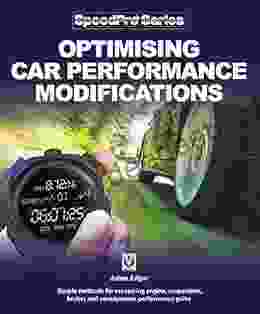Simple Methods For Measuring Engine Suspension Brakes And Aerodynamic

As an automotive engineer or enthusiast, it is important to be able to measure the performance of your vehicle's engine, suspension, brakes, and aerodynamic characteristics. This information can be used to evaluate the vehicle's performance and identify areas for improvement.
4.4 out of 5
| Language | : | English |
| File size | : | 13087 KB |
| Text-to-Speech | : | Enabled |
| Enhanced typesetting | : | Enabled |
| Print length | : | 178 pages |
| Lending | : | Enabled |
| Screen Reader | : | Supported |
There are a number of simple methods that can be used to measure these characteristics. In this article, we will provide an overview of these methods and discuss how they can be used to improve your vehicle's performance.
Measuring Engine Performance
There are a number of different ways to measure engine performance. Some of the most common methods include:
- Engine speed: This is the number of revolutions per minute (RPM) that the engine is running at. It can be measured using a tachometer.
- Torque: This is the amount of force that the engine is producing. It can be measured using a dynamometer.
- Horsepower: This is the amount of power that the engine is producing. It can be calculated using the following formula:
Horsepower = Torque x Engine speed / 5252
These measurements can be used to evaluate the engine's performance and identify areas for improvement. For example, if the engine is not producing enough power, it may be necessary to increase the engine speed or torque.
Measuring Suspension Performance
There are a number of different ways to measure suspension performance. Some of the most common methods include:
- Spring rate: This is the amount of force that is required to compress the suspension spring by a certain amount. It can be measured using a spring tester.
- Damping rate: This is the amount of force that is required to dampen the suspension movement. It can be measured using a damper tester.
- Roll stiffness: This is the amount of force that is required to roll the vehicle body by a certain amount. It can be measured using a roll stiffness tester.
These measurements can be used to evaluate the suspension's performance and identify areas for improvement. For example, if the suspension is too soft, it may be necessary to increase the spring rate or damping rate.
Measuring Brake Performance
There are a number of different ways to measure brake performance. Some of the most common methods include:
- Brake pedal force: This is the amount of force that is required to apply the brakes. It can be measured using a brake pedal force gauge.
- Brake torque: This is the amount of torque that is produced by the brakes. It can be measured using a brake torque meter.
- Brake fade: This is the decrease in brake performance that occurs as the brakes are used repeatedly. It can be measured by comparing the brake torque before and after a series of brake applications.
These measurements can be used to evaluate the brake's performance and identify areas for improvement. For example, if the brakes are not producing enough torque, it may be necessary to increase the brake pad size or the brake fluid pressure.
Measuring Aerodynamic Performance
There are a number of different ways to measure aerodynamic performance. Some of the most common methods include:
- Drag coefficient: This is a measure of the amount of drag that the vehicle experiences when it is moving through the air. It can be measured using a wind tunnel.
- Lift coefficient: This is a measure of the amount of lift that the vehicle experiences when it is moving through the air. It can be measured using a wind tunnel.
- Downforce: This is the amount of force that is generated by the vehicle's aerodynamic design to push it down onto the road surface. It can be measured using a force plate.
These measurements can be used to evaluate the aerodynamic performance of the vehicle and identify areas for improvement. For example, if the drag coefficient is too high, it may be necessary to reduce the vehicle's frontal area or streamline the vehicle's body.
The methods described in this article can be used to measure the performance of a vehicle's engine, suspension, brakes, and aerodynamic characteristics. This information can be used to evaluate the vehicle's performance and identify areas for improvement. By understanding these methods, automotive engineers and enthusiasts can improve the performance of their vehicles and make them safer and more enjoyable to drive.
4.4 out of 5
| Language | : | English |
| File size | : | 13087 KB |
| Text-to-Speech | : | Enabled |
| Enhanced typesetting | : | Enabled |
| Print length | : | 178 pages |
| Lending | : | Enabled |
| Screen Reader | : | Supported |
Do you want to contribute by writing guest posts on this blog?
Please contact us and send us a resume of previous articles that you have written.
 Book
Book Novel
Novel Page
Page Story
Story Library
Library Paperback
Paperback E-book
E-book Sentence
Sentence Bookmark
Bookmark Glossary
Glossary Bibliography
Bibliography Preface
Preface Synopsis
Synopsis Annotation
Annotation Manuscript
Manuscript Scroll
Scroll Classics
Classics Library card
Library card Biography
Biography Autobiography
Autobiography Thesaurus
Thesaurus Narrator
Narrator Character
Character Resolution
Resolution Card Catalog
Card Catalog Borrowing
Borrowing Stacks
Stacks Archives
Archives Periodicals
Periodicals Research
Research Lending
Lending Reserve
Reserve Academic
Academic Reading Room
Reading Room Rare Books
Rare Books Special Collections
Special Collections Thesis
Thesis Awards
Awards Reading List
Reading List Theory
Theory Pearl S Buck
Pearl S Buck Hannah Seaman
Hannah Seaman Amy J Lemke
Amy J Lemke Mike Shepherd
Mike Shepherd Ken Luber
Ken Luber Christopher Parton
Christopher Parton Chris Negron
Chris Negron Vicky Billingham
Vicky Billingham W Phillips Shively
W Phillips Shively Naghilia Desravines
Naghilia Desravines Henry Hazlitt
Henry Hazlitt Michelle M Nickerson
Michelle M Nickerson Sheila Christensen
Sheila Christensen Justin Thacker
Justin Thacker Herman Geuvers
Herman Geuvers Alice Anderson
Alice Anderson Joshua Kerievsky
Joshua Kerievsky Thomas F Brier Jr
Thomas F Brier Jr Michael S Sweeney
Michael S Sweeney Patrick Mcnamara
Patrick Mcnamara
Light bulbAdvertise smarter! Our strategic ad space ensures maximum exposure. Reserve your spot today!

 Roger TurnerPlay It Christmas Songs: The Ultimate Guide to Setting the Holiday Mood with...
Roger TurnerPlay It Christmas Songs: The Ultimate Guide to Setting the Holiday Mood with...
 Ronald SimmonsLDS Fingerstyle Guitar Hymns: A Beginner's Guide to Beautiful Worship Music
Ronald SimmonsLDS Fingerstyle Guitar Hymns: A Beginner's Guide to Beautiful Worship Music
 Marcus BellEnemy Zone: Trident Rescue - An Immersive First-Person Shooter That Packs a...
Marcus BellEnemy Zone: Trident Rescue - An Immersive First-Person Shooter That Packs a... Ross NelsonFollow ·19k
Ross NelsonFollow ·19k Jaime MitchellFollow ·6.2k
Jaime MitchellFollow ·6.2k Devon MitchellFollow ·19.1k
Devon MitchellFollow ·19.1k Adrien BlairFollow ·12.3k
Adrien BlairFollow ·12.3k Jake CarterFollow ·19.5k
Jake CarterFollow ·19.5k Emanuel BellFollow ·11.8k
Emanuel BellFollow ·11.8k Henry GreenFollow ·19.6k
Henry GreenFollow ·19.6k John UpdikeFollow ·2.4k
John UpdikeFollow ·2.4k

 Al Foster
Al FosterHow To Breathe Underwater: Unlocking the Secrets of...
: Embracing the...

 Ian Mitchell
Ian MitchellThe Laws of Gravity: A Literary Journey into the...
Lisa Ann Gallagher's...

 Francis Turner
Francis TurnerChristmas Solos For Beginning Viola: A Detailed Guide for...
Christmas is a time for...

 Jamal Blair
Jamal BlairDefine Humanistic Psychology Forms Of Communication...
Humanistic...

 Morris Carter
Morris CarterJudgment in Berlin: Unraveling the Intrigue of an...
"Judgment in Berlin" is a gripping...
4.4 out of 5
| Language | : | English |
| File size | : | 13087 KB |
| Text-to-Speech | : | Enabled |
| Enhanced typesetting | : | Enabled |
| Print length | : | 178 pages |
| Lending | : | Enabled |
| Screen Reader | : | Supported |








